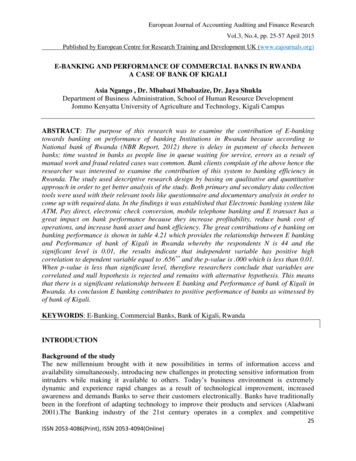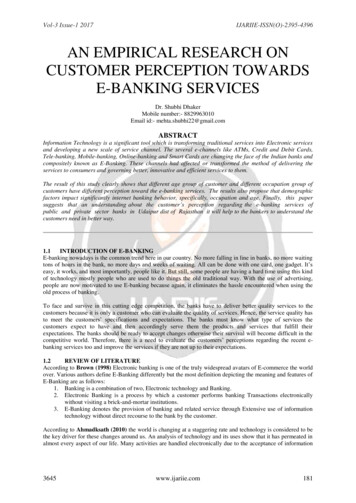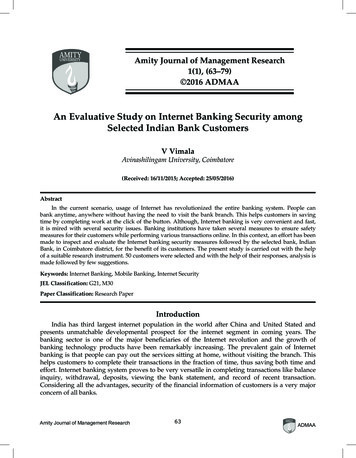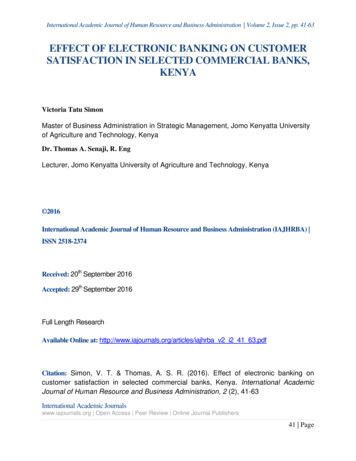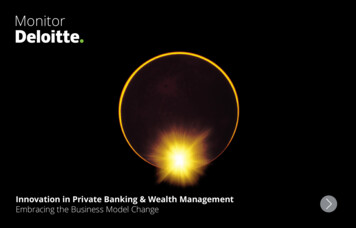
Transcription
MonitorInnovation in Private Banking & Wealth ManagementEmbracing the Business Model Change
Innovation in Private Banking & Wealth Management Embracing the Business Model ChangeGlossaryWealth ManagementFor reasons of simplification, Wealth Managementin this document refers to European Private Banking &Wealth Management. Wealth Management is the holistic financial management of wealthy clients (typicallywith assets in excess of EUR 1 million) and is characterised by personal relationships built on mutual trustand individual advice at the highest level. Wealth Management covers the full process of planning, realisingand controlling the wealth of clients, and can go beyond purely financial matters to include social and personal arrangements.2Wealth ManagersWealth Managers are institutional Private Banking &Wealth Management service providers in Europe,with a focus on business with private clients. They include pure-play private banks as well as Private Banking & Wealth Management units of universal or regional banks.FinTechsFinTechs are defined as companies that use financialtechnologies to support or enable financial services.Typically, they are internet companies that streamlinefinancial systems and make financial services more efficient. Today, there are more than 500 FinTechs activein Europe focusing on business areas such as crowdfunding, crypto currencies, data analytics, insurance,investment and asset management, market information or payments. Given the focus of this document,references to FinTechs exclusively relate to Europeancompanies that provide Private Banking & WealthManagement services to private clients or that provide technological solutions to Wealth Managersas defined on the left hand side.
Innovation in Private Banking & Wealth Management Embracing the Business Model ChangeExecutive Summary3
Executive SummaryExecutiveSummaryApproachCase forInnovationInnovation in Private Banking & Wealth Management Embracing the Business Model ChangeFinTechs and the time is about right Typically, innovations result from a conscious, purposeful search for innovation opportunities, which are found only in few situations, such as changesin the industry structure, demographics or in the perception of an industry, economic incongruities or the appearance of new knowledge. All thesecan be found today in the Wealth Management industry. An increasing number of FinTechs active in Wealth Management ( 300% in the past three years) isdisrupting traditional industry structures; millennials will form 50% of the global workforce by 2020, creating demographic change; and the global regulatory agenda has triggered the reshoring of assets, adversely affecting the prospects for cross-border Wealth Management.InnovationCornerSummaryMarket IntelligenceWealthManagersIt’s about time for innovation in Wealth Management Wealth Management has now reached a point where a mind shift has become essential. The profitability of European Wealth Managers has been in constant decline in recent years, with profit margins falling by 40% between 2000 and 2015. During the same period, the market size for Private Bankingmeasured by the bankable assets of European millionaire households has grown by more than 60%. This increasing gap between profitability and marketsize shows that Wealth Managers are failing more and more to serve clients successfully with their existing business models of an integrated value chain(average industry integration level of above 80%). This suggests that the industry is facing an innovation gap, since industrialisation and M&A – the othertwo main strategic growth levers – have already been employed for years.Contactsand SourcesSuccessfulInnovations but ambition is lackingInnovation ambitions for both Wealth Managers and FinTechs revolve around the existing core Wealth Management business. However, most innovations are a response to existing business challenges, and far fewer exploit opportunities to create value in a new way. Wealth Managers are mainly digitising their traditional business model to reduce their cost base; and FinTechs are either offering digital solutions to support Wealth Managers or areproviding digital offerings to compete for digitally-aware private clients. The innovation efforts of Wealth Managers are therefore concerned mainly withindustrialisation efforts, and those of FinTechs with disruption: neither are focusing on innovation to embrace a change of the Wealth Managementbusiness model.4
Executive Summary (continued)ExecutiveSummaryApproachCase forInnovationInnovation in Private Banking & Wealth Management Embracing the Business Model ChangeFinTechs requires a shift in the leadership’s mental model Innovations come to a halt, or fail, for many different reasons, but most often it is because superficial changes to improve performance are not sufficient to affect a fundamental transformation. Innovation requires change at a deeper level, a change of the leadership’s key beliefs as these typically affect attitudes and culture throughout the organisation. Wealth Management is built around traditional assumptions, behaviours and beliefsabout how to create value that drive the strategies leaders deploy and guide their decision-making. These assumptions and key beliefs need to beexposed to the new realities of today’s world and the future, by monitoring trends and their implications, and recognising the urgency and importance of innovation.InnovationCornerSummaryMarket IntelligenceWealthManagersEnabling innovations that can change the business model While eliciting a change of business model typically requires to employ multiple types of innovation with a focus on shifts in the profit model and client engagement, efforts in Wealth Management concentrate mainly on digitising processes and structures in the existing business model. Instead, WealthManagers could exploit innovation opportunities in a more transformational way by re-designing instead of reorganising their infrastructure (e.g.,through Cloud Computing, Open APIs, Orchestrating), deepening their understanding of client needs (e.g., through Social Listening, Instant Client Feedback), identifying new sources of revenue (e.g., supplementary Client Care Services, Digital Security Services) and refreshing their brand (e.g., throughSub-branding, Ingredient Branding).Contactsand SourcesSuccessfulInnovations and an effective innovation systemOnce the leadership is on board, innovation needs to be formally embedded as a management discipline and the corporate culture needsto be opened up towards divergent thinking. This calls for a systematic change that, based on an analysis of successful leaders in innovation, requiresfour building blocks to be in place: approach, organisation, resources and competencies, and metrics and incentives. A tailored approach should bebuilt around clear definitions and methodologies for the work to be done in generating innovations, and innovations should be managed as a portfolio.Accordingly, the appropriate talent and capabilities need to be acquired and nurtured. In this context, and as a starting point, Wealth Manager shouldclarify the role of partnerships.5
Innovation in Private Banking & Wealth Management Embracing the Business Model ChangeThe Case for Innovationin Private Banking & Wealth Management6
ExecutiveSummaryCase forInnovationWhat we mean by innovationOften equated with related disciplines such as digitisation, industrialisationand disruption, innovation is a much broader term depending on the creation of valueDistinct features of innovation1FinTechsInnovationSummaryMarket IntelligenceWealthManagersApproachInnovation in Private Banking & Wealth Management Embracing the Business Model erDigitisation In the context of a transforming banking ecosystem, innovation is often associated with other concepts and disciplines related to change, but their definitions clearly distinguish them:1)Innovation (as separate from invention) is the creation of a new(to the market or the world), viable (creating value for clients, stakeholdersand the organisation itself) business offering (ideally going beyond products to platforms, business models and client experience)2)Digitisation is the transformation of business activities by the introduction and use of information technology3)Industrialisation is the concept of reducing the cost base and re-thinking the value creation process through the elimination of redundancies,smart sourcing, automation and standardisation4)Disruption is a process whereby a smaller company with fewer resources is able to successfully challenge incumbent businesses; disruption typically originates in low-end or new-market niches As opposed to digitisation and disruption, innovation is depending on thecreation of economic value*; while industrialisation and innovation havethis in common, innovation is much broader in its application Disruption can be considered contradictory to industrialisation: while industrialisation is a process for players with mature business models to defendtheir market shares, disruption is a process for players with new businessmodels to gain shares of the marketSuccessfulInnovationsContactsand SourcesInnovation Innovationrequires anunderstandingof whetherclients needor desire aninvention, andalso how it can bedelivered Innovationhas to provideeconomic value*,i.e., it must beable to sustainitself, and returnin excess of itsweighted averagecost of capital Innovation doesnot have to benew to the world,only to a marketor an industry,and can be basedon previousadvances* Based on the Economic Value Estimation (EVE) model, the economic value of a potential innovation is assessed by (1) its reference value, i.e., the actual price of the next best alternative (e.g., the current state), and (2) the netdifferentiation value, i.e., the monetary value that a potential innovation creates, either in cost savings or increased income, minus any additional cost that incurs with it (e.g., switching costs)7
ExecutiveSummaryCase forInnovationWealth Management in decline: an innovation gap?Despite profitability being on the downturn for years, the Wealth Managementbusiness model remained unchanged suggesting today a substantial innovation gapIndex: Profitability of Wealth Managers vs. market volume, 2000-2020FinTechs121112?Δ 101SuccessfulInnovationsContactsand SourcesΔ 23100Δ 52Innovation gap?The continuouslygrown divergenceof Wealth Managers’profitability andmarket volumedevelopmentsuggests that,among other mainstrategic profitabilitylevers (e.g., M&A,industrialisation1)),Wealth Managementis facing aninnovation gap8969InnovationCornerSummaryMarket Intelligence Since 2000, the profitability of European Wealth Managers has declinedby nearly 40% (CAGR of -3.2%) despite market volume growth of more than60% (CAGR of 3.3%)162WealthManagersApproachInnovation in Private Banking & Wealth Management Embracing the Business Model Change6120002005201020152020 While the steep decline in profitability between 2005 and 2010 – accelerated by the financial crisis, changing client behaviour and regulation – has lessened in the recent past, the downtrend is still on-going substantially irrespective of the accelerated increase in market volume since 2010 (CAGR of 6.0% between 2010 and 2015) In 2015, the indices for market volume and Wealth Managers’ profitability have diverged by more than 100 percentage points from their individual levels of 2000 indicating that a low point for Wealth Management hadbeen reached The growing gap between profitability and market volume shows thatWealth Managers are failing more and more to serve clients successfully with their existing business models – either from a revenue or cost side,or, even worse, from both The forward-looking trend line (dotted line; based on CAGR 2000-2015) indicates that, should Wealth Managers not adjust their current set-up,questions whether Wealth Management will still be a profitable businessin the future will ariseKey:Market volume index (2000 100) represented by wealth2) of European millionaire households, 2000-2020Average profit margin index (2000 100) of European Wealth Managers, 2000-20201) Industrialisation levers include: Process Excellence, Organisational Efficiency, Product Rationalisation, Value Chain Re-engineering, IT Simplification, Location Optimisation, Industry Utilities and Joint Ventures, Process Digitisationand Robotics, Economic Value Management2) Wealth is defined as financial assets including onshore and offshore currency and deposits, debt securities, equity, investment funds shares, life insurance and annuity entitlements, pension entitlements and entitlementsto non-pension benefits8
Illustration of a business model life cycleProfitabilityExecutiveSummaryCase forInnovationApproachWith the current core business model for Wealth Management approaching the endof its life cycle, there is an urgent and growing need to develop nTechsWealthManagersWealth Management in decline: the end of the core business model?Core business modelSummaryMarket IntelligenceInnovation in Private Banking & Wealth Management Embracing the Business Model ChangeTime Once growth is established, management is in an adaptive mode,making short-term decisions and being reactive by making adjustments to the business model with the objective of increasing growthand profitability In the maturity phase, management is changing to a planning mode, driving analysis to increase efficiencies and developing strategies to maintainlevels of profitability. Ideally, management starts questioning whetherthe core business model can be successful in the future and develops ideasfor a new business model (green dashed line)InnovationCorner Once decline has started, only transformational innovations can enablenew business models, and adjustments to the core business model will onlydelay the end of the life cycle (grey dashed line)Characteristics of the current core business model in Wealth Management Focus on domestic on-/offshore business to affluent and high net worth clientswith an international footprint Offering of custody, advisory and brokerage services, as well as standardised and individualdiscretionary mandates Relationship Manager-driven coverage and service model (as opposed to specialist or desk/teamdriven model) Limited own-product manufacturing capabilities Highly integrated value chain (average industry integration of above 80%) with complexIT infrastructures Profit model based on client asset volumesSuccessfulInnovationsContactsand SourcesNew business modelBusiness modelinnovationOnce in thedecline phase,adjustmentsto the corebusinessmodel can onlyslow down itsextinction; thisis why thereis a growingurgencyto develop a newbusiness modelon the backof innovations Typically, the life cycle of a business model is characterised by an introductory phase, during which management is in an entrepreneurial mode andwilling to take risks, and losses are incurred to grow the business beforereaching breakeven9 As shown on the previous page, the current core business model in WealthManagement (see call-out box on the bottom left for characteristics) hasbeen in decline since 2000. Accordingly, adjustments will only slow downthe ongoing decline, while the urgency to develop new business modelsis increasing and forcing Wealth Managers to intensify transformationalinnovation efforts
ExecutiveSummaryCase forInnovationInsufficient strategic importance of innovationThe question for an innovation gap can be affirmed when comparing the strategicimportance of innovation in Wealth Management with that of other industries Relevance of innovation in Private Banking and Wealth ManagementR&Dinvestments44.8 in the EU ( bn)31.915.2AutomobilesPharma Technology9.2 7.65.2ElectronicsBanks2%Only 2% of the mostinnovative companies arebanks, and none of themspecialises in WealthManagement123Banking is the secondmost impactedindustry by digitaldisruptionsInnovationCornerThe number of FinTechstripled in the past three yearswhile the number of privatebanks has significantlydeclined123More than 3 out of 4Millennials would switchprivate banks if they finda better alternativeSuccessfulInnovationsContactsand Sources This is specifically paradox given the fact that Banking is the second most impacted industry by digital disruptions and thus banks should presumably attempt to overcome this challenge by investingin digital innovationsChemicalsInvestments in R&D, oneof the main indicatorsof innovation capacity,are lower in the bankingsector than in otherindustriesFinTechs In comparison to other industries, Banking in generalis lagging behind when it comes to innovation as boththe level of R&D investments and the ranking of banksamong the most innovative companies indicateSummaryMarket IntelligenceWealthManagersApproachInnovation in Private Banking & Wealth Management Embracing the Business Model mentWealth Managementis one of the leastdeveloped bankingsectors with regardsto digitisation For Wealth Management, a business that is traditionally based on trust and personal relationships, the backlog in terms of digitisation is even higher than for other banking sectors such as Retail or Investment Banking This is specifically alarming as 75% of Millennials – aspecifically tech-savvy and growing client segment –would switch their private bank if they found a betteralternative Considering the fact that the number of FinTechs – firmsthat on the back of technology-based business modelsoffer digital banking services – has tripled in Europe inthe past three years while the number of private bankshas steadily declined, which might hint that the creationof alternatives is already underway
ExecutiveSummaryCase forInnovationSituations favouring innovation opportunities and given the fact that most types of opportunity for innovationcan be found in Wealth Management already for some timeSituations favouring innovation opportunities 50In the past 3 years, more than 50 FinTechs have been disrupting the EuropeanWealth Management market with new technology-based business models, whileincumbent players held on to their traditional business model relying on personalinteraction and legacy systems50%The generational change over to the millennials is becoming increasingly noticeable;by 2020, they will form 50% of the global workforce and their wealth is expectedto double between 2015 and 2020 making them the upcoming key client segmentFinTechsDemographic changesInnovation opportunities created by changes in age distribution, education, numberof people, occupations or geographic locations have proven to be among the mostrewarding as they represent a shift of needs on the demand sideEconomic incongruitiesSummaryMarket IntelligenceWhen changes in an industry structure occur, incumbent players tend to focuson defending what they already have while neglecting smaller, fast-growing marketsegments and leaving innovators the chance to evolveInnovationCornerInnovation may arise from incongruities between economic realities, for instance,when the supply side’s assumptions of an industry and its dynamics divergefrom the expectations of the demand side 60%While the wealth of millionaire households (demand side) in Europe has increasedby more than 60% between 2000 and 2015, Wealth Managers’ profitability(supply side) has been on the downturn with profit margins falling by 40%over the same period (see p.8)-7%Against the backdrop of a global regulatory agenda the perceptionof the traditionally offshore-reliant Wealth Management business has takena turn for the worse; accordingly, Wealth Management Centres such as Switzerland(-7%), the UK (-21%) or Luxembourg (-11%) have experienced a slowdown of newinternational client assets since 2009EUR 3bnDigital investment solutions such as robo advisers are being picked up by privateclients only slowly in Europe with EUR 3bn in assets under management in 2015reflecting only a fraction of the EUR 18tn held in financial assets* by Europeanhouseholds in 2015 – a textbook example?Changes in perceptionChanging an industry’s perception from “the glass is half full” to “half empty”can drive significant innovation opportunities; this changed perception drives marketparticipants to reinvent themselves and the way they are doing businessSuccessfulInnovationsContactsand Sources and their relevance in Wealth ManagementIndustry changesWealthManagersApproachInnovation in Private Banking & Wealth Management Embracing the Business Model ChangeNew knowledgeKnowledge-based innovations – whether scientific, technical or social – are whatpeople commonly think of as innovation; however, as ground-breaking as they are,their success depends on the creation of economic value with long lead times* Financial assets include onshore and offshore currency and deposits, debt securities, equity, investment funds shares, life insurance and annuity entitlements, pension entitlements and entitlements to non-pension benefits11
Innovation in Private Banking & Wealth Management Embracing the Business Model ChangeMarket Intelligence on Innovationin Private Banking & Wealth ManagementApproach12
ExecutiveSummaryCase forInnovationMarket intelligence approachBased on a comprehensive view of the Wealth Management industry, we identified28 unique innovations from Wealth Managers and 11 from FinTechs Scope of and approach to market intelligenceWealth ManagersFinTechs 500 100 research papers reviewed65 WM professionals surveyed1)FinTechs in Europe analysed11665FinTechsinnovations in WealthManagement identifiedFinTechs focusing onWealth Management identified1128unique innovations 2)in Wealth Managementqualifiedunique innovations 2)in Wealth ManagementqualifiedSummaryMarket IntelligenceWealthManagersApproachInnovation in Private Banking & Wealth Management Embracing the Business Model Change10Contactsand SourcesSuccessfulInnovationsInnovationCornermost prevalent ideasdescribedDeloitte innovation corner8most prevalent 3)innovationsdescribed In order to gain a comprehensive view of innovations in the Private Wealth Management industry, weanalysed current innovations and innovation trendsfor both Wealth Managers and FinTech companies ForWealthManagers,wereviewedmorethan 100 recent reports and surveys looking for implemented, planned or intended innovations in the PrivateBanking and Wealth Management industry; we found116 innovations in Wealth Management and of these,28 were unique innovations; the 10 most prevalentwere then described in detail For FinTech, we analysed more than 500 Europeancompanies and identified 65 companies that specialise in Wealth Management of which we could identify 11unique innovations already implemented Innovations of both groups were then compared witheach other and commonalities, differences and whitespots were interpreted Finally, based on our view of the market and innovations observed in other industries, 13 innovation ideas in Wealth Management were described in an innovation cornerChapter 3bp. 16 et seqChapter 3cp. 23 et seqChapter 3dp. 27 et seqChapter 3dp. 30 et seq1) Wealth Management professionals have been surveyed as part of the study “Innovation in Wealth Management” conducted by Deloitte in collaboration with WealthBriefing2) Identified innovations were clustered as unique innovations; for example, robo advisers were counted only once as a unique innovation for Wealth Managers and FinTechs despite plenty of research focusing on this topicand a number of organisations offering robo advisory services3) Based on the unique innovations, the most prevalent innovations per innovation type (see p. 14) were assessed based on a frequency analysis following the number of mentions (Wealth Managers) and the number of companies(FinTechs) respectively13
Market intelligence approach.and mapped them according to their Type of Innovation and Innovation Ambitionto create a clear picture of where and how innovation takes place in Wealth ManagementTen Types of Innovation and Innovation AmbitionFinTechsACSummaryMarket IntelligenceWealthManagersTAdjacent: Leveraging emerging capabilities,offerings and processes different from those in usetoday, more advanced technology being used onlyin other sub-sectors of the industry to enableinnovations that address clients in adjacentmarkets as well as current clientsInnovationCorner14T k4StructureProcessConfigurationCore: Leveraging existing capabilities, offerings,processes and technology already being usedin the industry to enable innovation with respectto existing clients as well as known and currentclient needsInnovation matrixWhile the innovation ambition representsthe overall potential to change the waybusiness is done today’ (“where to play”),the type of innovation indicates the areasof the business it affects (“how to win”)SuccessfulInnovationsContactsand SourcesTransformational: Leveragingbreakthrough capabilities, offerings,processes and technology newto the industry to enable innovationintended for brand new client segments addressingcompletely new client needsInnovation Ambition“Where to play”ExecutiveSummaryCase forInnovationApproachInnovation in Private Banking & Wealth Management Embracing the Business Model Change5 Productperformance6 Productsystem7Offering8Service9ChannelBrand10 ClientengagementExperienceType of Innovation “How to win”1Profit model: Finding fresh ways to convert offerings intorevenues by understanding what clients actually cherish6Product system: Connecting and bundling individual offeringto create complementary products and services2Network: Identifying how to benefit from other firms’processes, channels, technologies, offerings or brands7Service: Amplify the utility, performance and apparent valueof offerings to create compelling client experiences3Structure: Organising and aligning talent and assetsto create value more productively and effectively8Channel: Rejuvenating how to connect with clients and deliverproducts and services to them4Process: Using unique, superior capabilities and methodsto produce offerings more flexibly and efficiently9Brand: Distilling a brand promise that attracts clientsand ensures they recognise, remember and prefer the offering5Product performance: Improving value, features, and qualityof offerings incl. new products and product updates10Client engagement: Creating meaningful connectionswith clients by understanding their deep-seated aspirations
Innovation in Private Banking & Wealth Management Embracing the Business Model ChangeMarket Intelligence on Innovationin Private Banking & Wealth ManagementWealth Manager Lens15
Innovations addressed today are mainly configuration and experience driven, and revolvearound the core business with only outliers touching transformational ideasCurrent relevance of innovation for European Wealth ManagersDegree of ambitionExecutiveSummaryCase forInnovationApproachWealthManagersFocus areas of innovation today: Wealth ManagersT %01%009%3%6%17%17%1%3%9%9%6%15%86%10 Clientengagement CCoreFinTechsMarket IntelligenceInnovation in Private Banking & Wealth Management Embracing the Business Model Change1 5 Product 6 Product erienceSummaryType of innovationInnovationCornerStructure and ProcessWith cost reduction being oneof the most important strategicpriorities for Wealth Managers,innovations enabling efficiencygains are targeted on a large scaleKey:Focus areas of innovation basedon identified innovations (n 116):SuccessfulInnovations 10% 5-10% 1-5% 0-1%Contactsand Sources016Services and ChannelBuilding digital capabilities isthe most prevalent innovationin WM, although it can be ratherconsidered as catching upwith other areas of banking orindustriesBrandDespite the fact that the financialcrises have undermined clients’trust in banks, the need to refreshbrand identity does not appearto be imminent Today, Wealth Management providers mainly focus their intended innovations around areas thatare core (86%) and to a limited degree adjacent (9%)to the traditional business model suggesting the industry is still holding on to its “past days of plenty” However, this might be deceiving as Wealth Management is a slow and intangible business characterisedby personal interaction and trust, which requirestime to be receptive to transformational innovations While banks have understood that the digital transformation is inevitable, there is no uniformity with regardsto the degree of digitisation of the business,i.e., the right mix of digital and personal interactions Accordingly, they have focused on more obvious innovations aiming to increase efficiencies (structure andprocess) and catching up with digital backlog in clientcommunications (service and channel) Other areas, however, such as brand eminenceor advancement of profit models have remained mainly untouched, while transformational innovations suchas the robo adviser are perceived with scepticism Detailed descriptions of the most prevalentunique innovations from Wealth Managers arepresented in the following
Most prevalent unique innovations: ConfigurationDriven by the continuous decline of profitability, Wealth Managers shift towards valuebased pricing models and consider collaborations with FinTechsExecutiveSummaryApproachCase forInnovationInnovation in Private Banking & Wealth Management Embracing the Business Model ChangeValue-based pricing modelsColl
Innovation in Private Banking & Wealth Management mrain e siness oel Cane 5 Enabling innovations that can change the business model While eliciting a change of business model typically requires to employ multiple types of innovation with a focus on shifts in the profit model and cli - ent engagement, efforts in Wealth Management concentrate mainly on digitising processes and structures in .


